-
Car Reviews
- All reviews
- Midsize SUVs
- Small cars
- Utes
- Small SUVs
- Large SUVs
- Large cars
- Sports SUVs
- Sports cars
- Vans
Latest reviews
- Car News
-
Car Comparisons
Latest comparisons
- Chasing Deals
New hybrid engine brings better fuel economy plus desirable turbo-petrol-AWD combination to the Santa Fe for the first time
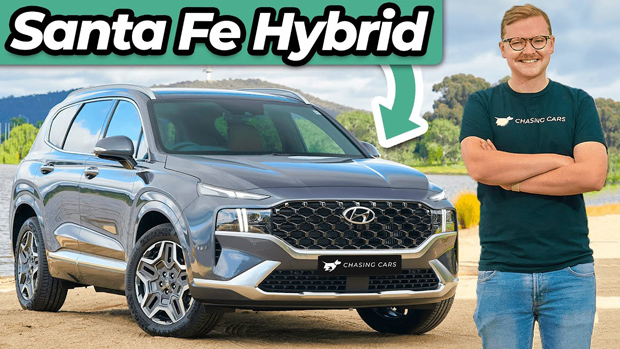
Hyundai is launching a range of fully-electric cars at different price points in Australia – but while it does so, the South Korean brand is also embarking on a project to make its petrol engines cleaner. That effort will be based around transitioning the petrol engines it sells in Australia to hybrid powertrains over the next few years.
The Santa Fe three-row SUV is the first mainstream Hyundai model to go down this path. While traditional V6 petrol and turbo-diesel engine options remain available to buyers, the new Santa Fe hybrid option shows Australians where Hyundai will direct most of its petrol-powered efforts from now on.

Tight supply means the new 1.6-litre turbo petrol AWD hybrid engine will only be offered on the mid-spec Santa Fe Elite grade (about $68K driveaway), and the top-shelf Highlander on test (about $75K DA). That makes the hybrid a $3000 upgrade over the extremely popular 2.2-litre diesel AWD engine that accounts for nearly nine in 10 Santa Fe sales in Australia.
An all-new Santa Fe is about 18 months away from landing in Australia, and we expect that model will, like the Toyota Kluger, make hybrid engines a key part of the range.
But Aussies basically get an early preview of Hyundai’s hybrid future in this, the twilight era of the fourth-gen Santa Fe.
Not that it feels like a car in its twilight: Hyundai has significantly improved the current Santa Fe over the course of its lifetime, to the point where it still feels – and looks – pretty new and fresh compared to key rivals like the Mazda CX-8.
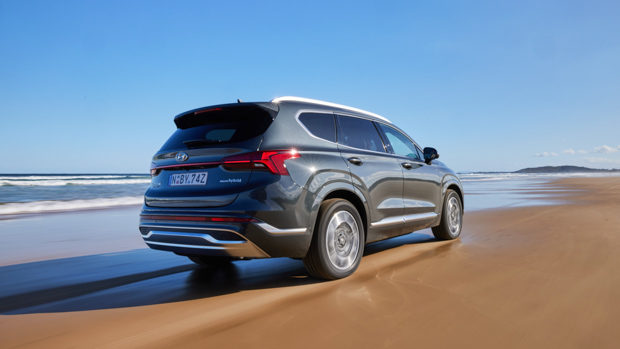
You can’t get a hybrid CX-8, but you can join a (long) waitlist to purchase a hybrid version of the Santa Fe’s cousin, the Kia Sorento (from $72K DA). And, of course, there’s the Toyota Kluger hybrid (from $59K DA), which is larger than the Santa Fe, and uses the latest version of Toyota’s tried-and-tested hybrid system.
By contrast, Hyundai is relatively new to building hybrid-powered family SUVs. Does their system work well? Is it a better buy than the Toyota? And what kinds of buyers are likely to ‘get ahead’ economically by purchasing the hybrid rather than the diesel? Let’s find out!
Because the Santa Fe’s new hybrid engine is isolated to the well-equipped Elite and $6550-dearer Highlander grades, it is generously specified out of the box.
Most Australian buyers should find the Santa Fe Hybrid Elite to offer more than enough standard kit for their needs – but the Highlander model we spent most of our 900km test drive in does bring some nice additional goodies that you might value.
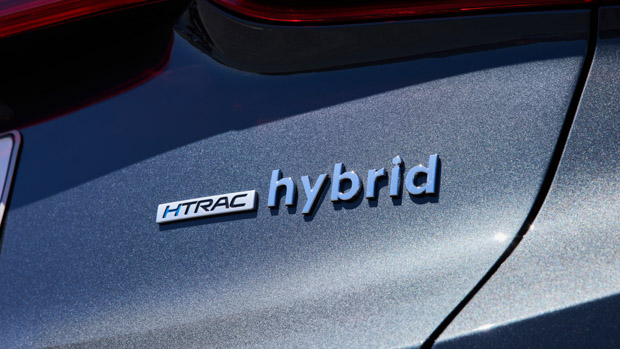
Keep in mind that the equipment inclusions are largely identical to the diesel version of the Santa Fe, meaning the $3000 upcharge for hybrid power is basically only going into changing the engine.
Standard on the Santa Fe Hybrid Elite model, which costs about $68K driveaway in NSW, is:
The $6550 step up to the Highlander on test brings these additional features:
In our judgment, the Elite comes family-friendly with leather, premium audio, and a good suite of safety technology. However, some families will appreciate the cooled front seats and panoramic sunroof of the Highlander. We also prefer the blind spot camera system and body-coloured cladding of the top-spec car.
We remain critical of the fact that Hyundai isolates a crucial safety feature – reversing autonomous emergency braking – to the top-spec Highlander. This tech should be standard range-wide, as it is on the Mazda CX-8.
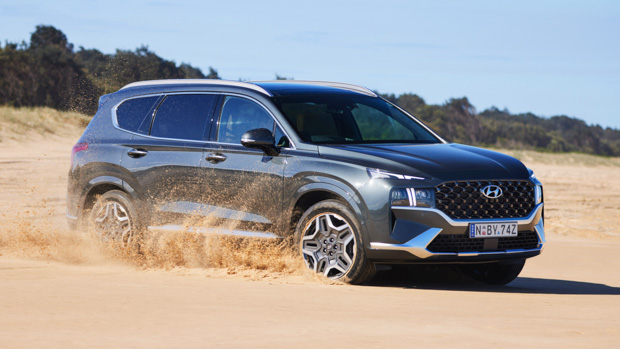
The addition of a hybrid powertrain to the Santa Fe mainly concentrates on the engine department, but the extra weight of the petrol-electric version – it’s 20-30kg weightier than the diesel, at about 1980kg – means there has also been a subtle suspension retune.
This re-tune of the ride and handling was completed by Hyundai’s engineers in Korea and then validated on a difficult road loop near the Hunter Valley in New South Wales, where Hyundai Australia’s chassis professionals gave it the tick of approval.
We agree with their judgment. We borrowed a Santa Fe Hybrid Highlander for a punishing 900km drive that took in a varied mix of urban, separated highway, regional B-road and gravel C-road segments to really get to know the car.
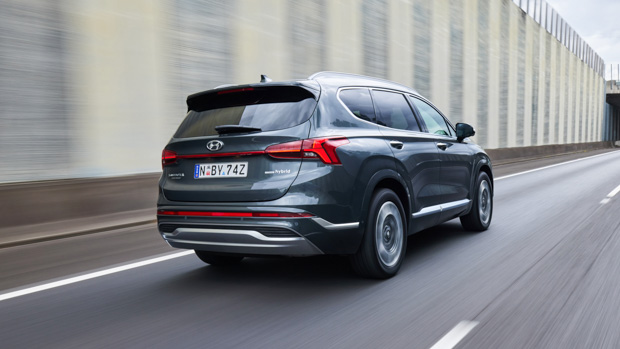
When the fourth-generation Santa Fe launched in 2018, we wrote that the ride quality was overly firm, with a clear bias towards body control over comfort. While that choice endowed the Hyundai with great high-speed handling, it did make it quite stiff at lower speeds.
A better balance was struck at facelift time, when a rethink of the Santa Fe’s suspension priorities was pushed through. More supple ride quality eventuated, but the Hyundai’s trademark excellent country-road control and compliance remained almost entirely intact. It really was good work.
Our honest testing loop revealed that the facelifted Santa Fe’s virtues are baked into the hybrid too. At low speeds, the Santa Fe hybrid is relaxed and comfortable. On the highway, it’s stable with no head toss. And on a backroad, you can maintain a really good clip with the car soaking up rain-induced potholes admirably.
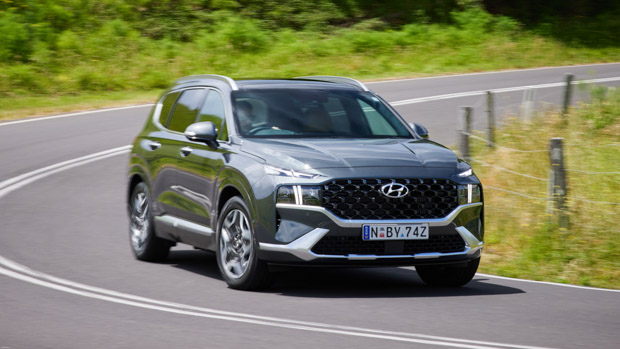
Compared to the diesel, which we’ve rated highly at Chasing Cars, the hybrid requires half a second more patience when turning into a corner as the weight takes just a hair longer to settle – but shod in very good Continental ContiSport tyres, very few families will ever find this SUV’s remarkably high handling limits.
As for the hybrid powertrain: simply put, it’s a good one. The use of a turbocharged petrol four-cylinder engine as the base of the system is enlightened.
Compared to Toyota’s familiar and long-running hybrid engines, which use naturally-aspirated petrol engines that require a loud rev when overtaking, the Hyundai feels serene, quiet and muscular.
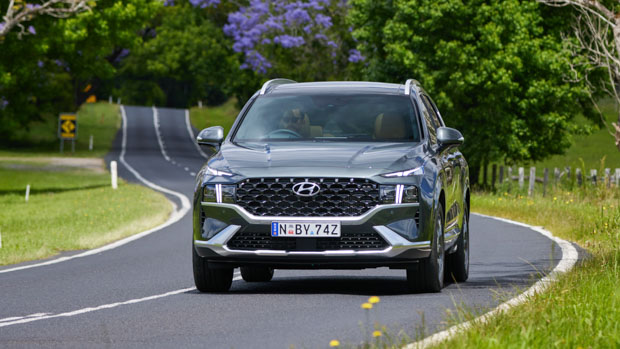
The combined outputs of 169kW of power and 350Nm of torque give a clear indication of the amount of performance available. While the Santa Fe hybrid is no sports SUV, it has good authority on the road with plenty of power for merging onto the highway or overtaking trucks.
That said, the system isn’t perfect. The Santa Fe hybrid uses a traditional six-speed torque converter automatic (instead of a CVT-like transmission that is more common for hybrids). Most of the time, the traditional auto delivers superior refinement, but there is the occasional clunky shift from where the petrol and electric components don’t seem to agree.
Like the diesel version of the Santa Fe, the hybrid engine is AWD-only in Australia. This contrasts to the V6 petrol, which is front-wheel drive only due to packaging issues. The Toyota Kluger hybrid is also available only in AWD, though Kia sells a Sorento GT-Line hybrid with FWD, making it about $2800 cheaper than the Santa Fe if you can live without all-paw grip.
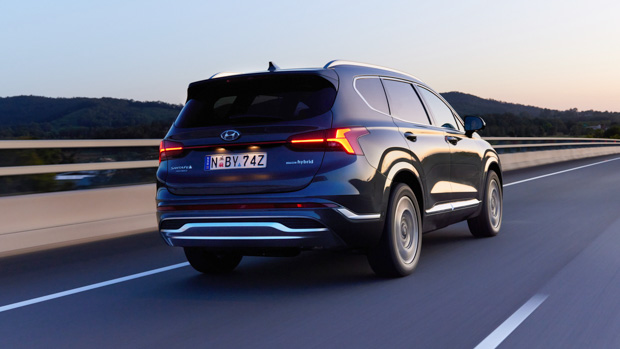
We were surprised by how weak the electric motor feels in the Santa Fe when setting off from rest. With 44kW/264Nm of rated outputs, the EV component should have sufficient torque to gently pull this SUV up to 50-60km/h – as Toyota’s hybrids can – but the Hyundai basically always switches the engine on when accelerating from a red light.
That undoubtedly limits how frugal the car can be, as accelerating from rest is one of the thirstiest parts of the driving cycle.
That said, once you’re up to speed in urban areas the Hyundai almost immediately settles into EV mode, where it spends about half its time – allowing it to deliver very good, if not great, fuel economy of about 6.5L/100km in town.
There are essentially no noticeable changes to the Santa Fe’s interior with the addition of a hybrid powertrain – and that’s fine.
At facelift time, Hyundai not only delivered a better quality of ride to the Santa Fe SUV – they also radically upgraded the interior design and finish of most models, but especially the Highlander.

The mid-spec Elite feels semi-premium, but the nappa leather-shod Highlander grade sits in a near-luxury arena that is not far off the serenity of a Genesis GV70 (from $75K DA).
We think that it’s worth spending $295 on the option of camel tan leather. As standard, the Highlander’s interior is finished in hardy black, but we’ve found that tan typically ages well while providing a brighter and even more sumptuous looking cabin.
The Santa Fe is not the newest large SUV out there, and its twin-screen pod is starting to look a little dated, but the software that runs on the crisp 12.3-inch digital driver’s display and 10.25-inch central touchscreen is easy to understand and interact with.

Hyundai’s built-in satellite navigation is among the easiest to use in the car industry, the menu structures aren’t too deep, and the instruments are very clear and easy to read. Plus, the Santa Fe retains hard buttons for virtually every common control, from the fan speed to the drive modes.
It’s frustrating that Hyundai still has not resolved its dispute around making Apple CarPlay (and Android Auto) wireless in their cars. When the equivalent Mazda, Volkswagen, and Skoda all have this ability, the Hyundai seems old-school. Even Toyota is adopting this tech! Also, you won’t find any fast USB-C ports here: just the old USB-A shape.
Once you’ve fished out an old cable and got your phone hooked up, though, CarPlay presents crisply on the middle screen and makes the car even easier to interact with. The Harman-Kardon premium stereo can sound excellent, but it requires extensive tinkering with the EQ to get it right. We eventually found the sweet spot.
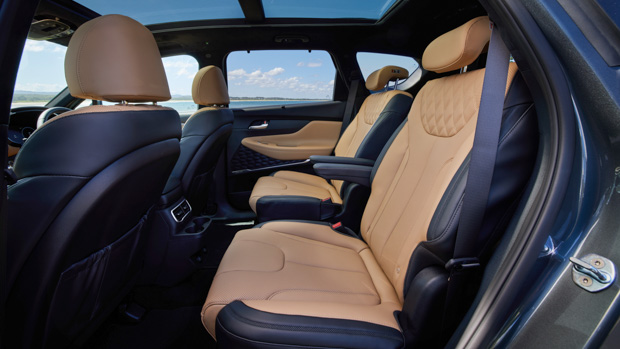
High-quality audio joins excellent seat ergonomics in making the Santa Fe a brilliant road trip car. We emerged from one 500km stint feeling just fine, partially thanks to the sculpted nappa leather driver’s seat with its extensive 12 ways of adjustment – two more ways than the Elite.
Seat cooling is also a near godsend in an Australian summer. If you’ve never used it you may not appreciate how calming it is to just … not … have a sweaty back in the car.
Fit and finish is mostly good and nearly every surface is lined in something resembling leather, or at least slush-moulded soft plastic. However, two examples of Santa Fe Hybrid that we drove had light rattles in their driver’s door. Turning the stereo up helped, and to be fair, we were driving on very coarse chip.

Moving backwards reveals a choice for buyers: you can now configure the Santa Fe Highlander with either plush second-row captain’s chairs (lucky kids!), or a more traditional three-across second-row bench. This choice makes the total seat capacity of the SUV either six seats or seven seats.
We think most families will choose the bench seat, but we adore the captain’s chair layout: it makes walking through to the (quite usable) third row a cinch, while giving second-row passengers greater comfort in their individual, heated pews.
Speaking of the third row, while it’s got individual AC control – a real plus for staving off car-sickness – its airbags only cover the glass, not the torso area. That is a miss we imagine Hyundai will solve for the next-gen Santa Fe that will be revealed next year.
A power tailgate is standard on the Santa Fe Hybrid and it rises to reveal 571 litres of space when five seats are in place. It’s a good, square boot, and the third row seats are light and easy to erect. Plus, there is a full-size spare underslung the vehicle, providing extra peace of mind in country touring.

While we reiterate our justified complaint that Hyundai restricts reversing AEB to the top-spec Highlander, the Santa Fe is generally a very safe car.
It has been some time since crash testing body ANCAP tested the Santa Fe. It happened in 2018, when the SUV received a five-star result against criteria that have now been superceded.
However, Hyundai continues to make a broad suite of safety features standard range-wide, including:
At the Highlander level, the suite is built out considerably to the fullest it can be on a Santa Fe. In addition to the above, Highlander buyers score:
In addition to the box-ticking exercise of having all these safety features, we are impressed at how well-tuned the features we were able to test were.
Hyundai remains at the forefront of smooth, well-implemented semi-autonomous safety tech that makes drivers more likely to leave them switched on. Only safety features that are switched on can help you – and if they are annoying or poorly tuned, it’s no surprise drivers want to turn them off. That is not a problem here.
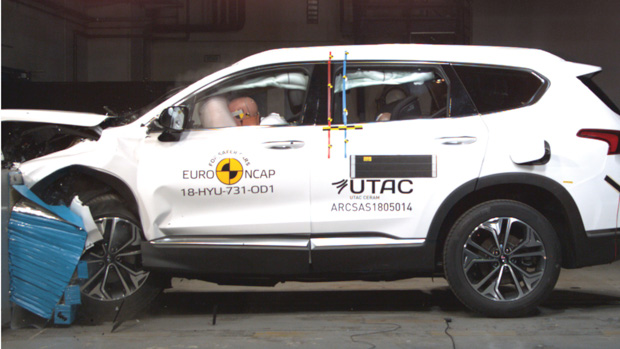
In particular, the Santa Fe’s adaptive cruise control system and strong lane centring work beautifully, alleviating fatigue on the kind of long road trips we subjected the car to in our testing.
In addition, we give additional credit to the Santa Fe Highlander’s innovative blind spot camera system, which presents a clear view of the left or right blind spot in the large digital driver’s display when the indicator is activated.
This Hyundai blind spot camera system is still the best blind spot monitoring system we have ever tested. We would like to see this tech proliferate through the entire Santa Fe lineup; at present, it’s only fitted to the top-specification (and most expensive) model.
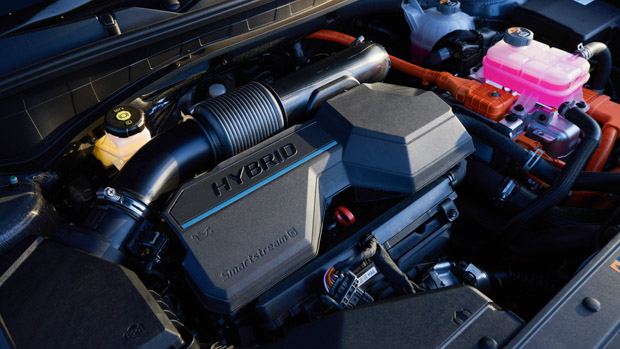
While the Santa Fe Hybrid has better urban fuel consumption than its diesel – and especially its V6 petrol – siblings, whether you will come out ahead by spending $3000 more to buy the hybrid over the diesel is a question of what kind of driving you do.
Let’s assume petrol stays at $2.00 per litre and diesel remains around $2.30 per litre.
| Engine | Driveaway $ | 5 years fuel | 5 year spend |
| V6 (13L/100km) | $68,000 | $19,500 | $87,500 |
| Diesel (8L/100km) | $72,000 | $13,800 | $85,800 |
| Hybrid (7L/100km) | $75,000 | $10,500 | $85,500 |
So, if you’re the kind of person that drives partially in town and partially on the highway, you can see that the diesel and the hybrid end up about lineball – so you might as well buy the diesel, which keeps more cash in your pocket rather than financing a car purchase.
If you do nearly all your driving in the countryside at higher speeds, the message is simple: buy the diesel.
| Engine | Driveaway $ | 5 years fuel | 5 year spend |
| V6 (15L/100km) | $68,000 | $22,500 | $90,500 |
| Diesel (9L/100km) | $72,000 | $15,525 | $87,525 |
| Hybrid (6.5L/100km) | $75,000 | $9750 | $84,750 |
As you can see, if you are the kind of driver who spends nearly all their time in the ‘burbs, you’ll come out well ahead with the hybrid. Over five years, not only does the hybrid recoup its initial $3000 disadvantage compared to the diesel, it is almost $3000 cheaper to fuel over that time period too.
That means that the Santa Fe hybrid, being $3000 more expensive than the diesel to buy, really only makes economic sense if you do lots of kilometres at low speed – classic hybrid areas!
Of course, you still might want to choose the hybrid if you have a personal goal to lower your own automotive CO2 footprint, but you are not ready to go fully electric.
And who does the V6 petrol suit? Mainly buyers doing very low kilometres, where the pain of higher fuel consumption won’t be enough to outweigh that car’s low purchase price.
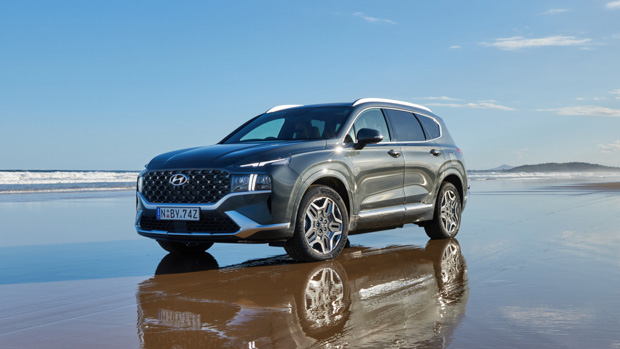
As for servicing: it’s required every 12 months/10,000km, which is a little sooner than we’d like.
At the time of writing, Hyundai had not yet confirmed service pricing, but indicated that it would be about $2500 total over five years. Compared to the Toyota Kluger hybrid, which costs just $1250 total to service for five years, the Hyundai is costly to maintain.
Hyundai covers the Santa Fe with a five-year, unlimited-kilometre warranty, plus an eight-year/160,000km warranty for the high-voltage components. That’s all okay, but the related Kia Sorento hybrid has a more generous seven-year/unlimited-kilometre vehicle warranty.
The Hyundai Santa Fe Hybrid is a welcome addition to the family SUV space in Australia. It gives Santa Fe buyers a peachy combination of turbo petrol power, AWD traction, and lower fuel consumption thanks to its petrol-electric system.
However, the pricing of the vehicle – and our analysis of its running costs – makes clear that the buyers best suited by the hybrid version of the Santa Fe are urban-dwellers who do plenty of kilometres in the ‘burbs, and mostly shy away from long miles in the country.
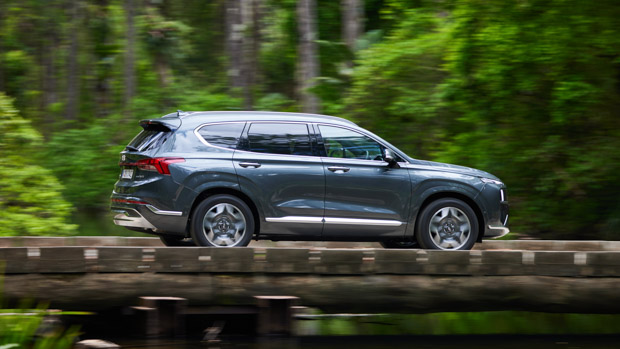
For those that do plenty of time on the highway, the excellent Santa Fe diesel remains our pick.
However, the smoothness and refinement of the turbo-petrol hybrid means that this version of the Hyundai would be a great companion for everyday urban use, what with its well-finished cabin and usable third row.
As with the related Kia Sorento HEV, supply is tight – in fact, there are just a few hundred units of Santa Fe Hybrid available to Australians until perhaps mid-2023 – so those interested need to move fast to avoid a waitlist.
Key specs (as tested)
About Chasing cars
Chasing Cars reviews are 100% independent.
Because we are powered by Budget Direct Insurance, we don’t receive advertising or sales revenue from car manufacturers.
We’re truly independent – giving you Australia’s best car reviews.
The estimate provided does not take into account your personal circumstances but is intended to give a general indication of the cost of insurance, in order to obtain a complete quote, please visit www.budgetdirect.com.au. Estimate includes 15%^ online discount.
^Conditions Apply
Budget Direct Insurance arranged by Auto & General Services Pty Ltd ACN 003 617 909(AGS) AFSL 241 411, for and on behalf of the insurer, Auto & General Insurance Company Limited(ABN 42 111 586 353, AFSL 285 571).Because we don’t know your financial needs, we can’t advise you if this insurance will suit you. You should consider your needs and the Product Disclosure Statement before making a decision to buy insurance. Terms and conditions apply.
Indicative quote based on assumptions including postcode , 40 year old male with no offences, licence suspensions or claims in the last 5 years, a NCD Rating 1 and no younger drivers listed. White car, driven up to 10,000kms a year, unfinanced, with no modifications, factory options and/or non-standard accessories, private use only and garaged at night.
^Online Discounts Terms & Conditions
1. Discounts apply to the premium paid for a new Budget Direct Gold Comprehensive Car Insurance, Third Party Property Only or Third Party Property, Fire & Theft Insurance policy initiated online on or after 29 March 2017. Discounts do not apply to optional Roadside Assistance.
2. Discounts do not apply to any renewal offer of insurance.
3. Discounts only apply to the insurance portion of the premium. Discounts are applied before government charges, taxes, levies and fees, including instalment processing fees (as applicable). The full extent of discounts may therefore be impacted.
4. We reserve the right to change the offer without notice.